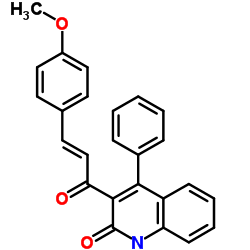1402830-75-4
| Name | 3-[(2E)-3-(4-Methoxyphenyl)-2-propenoyl]-4-phenyl-2(1H)-quinolinone |
|---|---|
| Synonyms |
3-[(2E)-3-(4-Methoxyphenyl)-2-propenoyl]-4-phenyl-2(1H)-quinolinone
2(1H)-Quinolinone, 3-[(2E)-3-(4-methoxyphenyl)-1-oxo-2-propen-1-yl]-4-phenyl- |
| Description | Ceranib-2 is a potent and nonlipid ceramidase inhibitor that inhibits cellular ceramidase activity with an IC50 of 28 μM in SKOV3 cells. Ceranib-2 induces the accumulation of multiple ceramide species, decreases levels of sphingosine and sphingosine-1-phosphate (S1P), and induces cell apoptosis. Anticancer activity[1][2]. |
|---|---|
| Related Catalog | |
| Target |
IC50: 28 μM (Ceramidase)[1] |
| In Vitro | Ceranib-2 (10 nM-10 µM; 72 hours; SKOV3 cells) treatment inhibits cell proliferation and/or survival with an IC50 value of 0.73 μM[1]. Ceranib-2 (0.75-1.5 µM; 48 hours; SKOV3 cells) treatment causes accumulation of cells in the sub-G1 (apoptosis), G2 and S (0.75 μM only) phases of the cell cycle, concomitant with reductions in the number of cells in G1 phase[1]. Ceranib-2 produces a dose-dependent decrease in ceramidase activity, with 50% inhibition at 28 μM, induces the accumulation of multiple ceramide species, and decreases levels of sphingosine and S1P[1]. Cell Proliferation Assay[1] Cell Line: SKOV3 cells Concentration: 10 nM-10 µM Incubation Time: 72 hours Result: Cell proliferation and/or survival were inhibited with an IC50 value of 0.73 μM for Ceranib-2. Cell Cycle Analysis[1] Cell Line: SKOV3 cells Concentration: 0.75 μM, or 1.5 μM Incubation Time: 48 hours Result: Induced cell-cycle arrest and cell death. |
| In Vivo | Ceranib-2 (20-50 mg/kg; intraperitoneal injection; daily for 5 days per week; for 3 weeks; female Balb/c mice) treatment delays tumor growth in a syngeneic tumor model without hematologic suppression or overt signs of toxicity[1]. Intraperitoneal administration of 50 mg/kg Ceranib-2 results in progressive increases in its circulating levels, reaching a peak plasma concentration of approximately 40 μM at the 2 hr time point. Ceranib-2 appears to be cleared with a half-life of less than 2 hr[1]. Animal Model: Female Balb/c mice injected with JC murine mammary adenocarcinoma cells[1] Dosage: 20 mg/kg or 50 mg/kg Administration: Intraperitoneal injection; daily for 5 days per week; for 3 weeks Result: Delayed tumor growth in a syngeneic tumor model. |
| References |
| Density | 1.2±0.1 g/cm3 |
|---|---|
| Boiling Point | 629.2±55.0 °C at 760 mmHg |
| Molecular Formula | C25H19NO3 |
| Molecular Weight | 381.423 |
| Flash Point | 334.4±31.5 °C |
| Exact Mass | 381.136505 |
| LogP | 4.90 |
| Vapour Pressure | 0.0±1.8 mmHg at 25°C |
| Index of Refraction | 1.657 |

